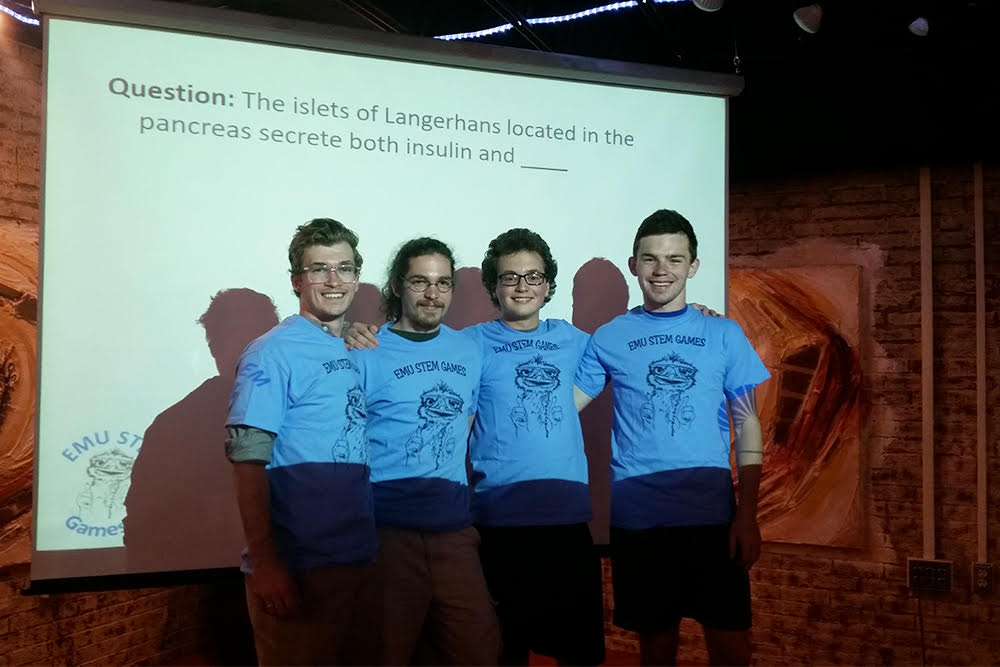The Salticids AKA the Jumping Spiders, comprised of Elliott Bowman, Cameron Byer, Jake Myers and Seth Weaver, were crowned champions of Wednesday evening’s STEM Games Quiz Bowl at Eastern Mennonite University. The trivia contest has been hosted near the end of the spring semester since 2013.
Last year, it became the first official event of (and kind of like a STEM pre-party to) the university’s Academic and Creative Excellence Festival held the next day. The ACE Festival is a campus-wide culmination of the academic year with oral and poster presentations, art exhibitions and talks, concerts and performances.
Each of the eight teams competing in the STEM Quiz Bowl — among them the creatively named Team Entropically Favorable and Team No Math (who were indeed blessed in the random question selection with their wish) — included 3-4 members with a mix of majors and underclass/upperclass status.
The Salticids rode to victory on a (randomly chosen) slew of mathematics-related questions, offering the correct answers to such brainteasers as
- the total number of two-element subsets that can be formed from the 26 letters of the alphabet (325) and
- the sum of all interior angles of an octagon (1080).
- Questions about chemistry and physiology were also summarily batted aside with ease.
For their efforts, the quartet donned light blue t-shirts adorned with an emu giving a primary-feather-up (designed by a former visiting professor, Abigail Berkey). Only faculty members and past STEM Games champions possess the shirts, which have become a status symbol over the years, said department chair Tara Kishbaugh.
Kishbaugh was among 10 STEM faculty members in attendance at the games, which were moved from the traditional site in the iconic SC-106, currently under renovation, to Common Grounds Coffeehouse.
Professor Daniel King used his engineering prowess to attend to the first soundwaves of each team’s acoustic devices (cowbells, mortar and pestle, etc.).
Professor Jeff Copeland kept a somewhat accurate score throughout. Professor Steve Cessna raised his arms in triumph when one of his plant biology questions (Is a bay magnolia tree a dicot or monocot? Answer: neither) stumped both teams.
Some incorrect answers, or even correct answers delayed by excessive memory searching, drew groans from the attending professors.
Professor Laurie Yoder was excessively pleased when one of her questions — the identification of a mysterious equation — went unanswered because, as she noted, with some relief, “No one here has taken the class.” If they had, it would have been easily recognizable as Schrödinger’s equation (“cat in a box,” some wiseacre yelled, too late).
Chemistry professor Matt Siderhurst MC’ed the event, occasionally mispronouncing multisyllabic terms from outside his field and offering a side-commentary that diverged into the arcane: i.e., after reading the question, “Coat patterning in tortoiseshell calico cats is the result of what genetic factor?” Siderhurst queried the crowd, “If they have orange in their coats, doesn’t that mean they came with the Vikings?”*
(Across the room, Copeland paused from his attentive counting of questions and accrued points and somewhat sadly shook his head.)
The “phone-a-friend/lifeline” option resulted in opportunities for public shame and betrayal. Daniel Harker, for example, denied a request by the flailing Salticids to answer a question in a field of his apparent expertise. One member of the No Maths squad waved away the issued lifeline from another team, claiming he had failed that particular exam.
Interspersed with the hardcore science trivia were questions asking competitors to identify faculty members by their academic degree-granting institutions, perhaps the name of published research, or their children’s names.
The internationals among the faculty were most quickly identified: Professor Kris Schmidt’s descriptive phrase got only so far as the word Manitoba before the cowbell rang; swiftly named as a denizen, for all three of his degrees, from the University of Rome was EMU’s newest computer science professor, Dottore Stefano Colafranceschi. Questions about research into T-Cells and ruffed grouse as topics of interest for Professor Julia Halterman and Professor Jim Yoder were also easy pickings.
During intermissions between team duals, junior Melissa Kinkaid posed questions asking faculty to identify senior STEM majors by quirky personality traits and life experiences (for example, which senior broke a test tube, and then a beaker, too, on her first day of O Chem?). Copeland won the prize of a battered and unclaimed aluminum water bottle that everyone was tired of seeing in Suter Science Center.
Snacks were available, of course, and a good time was had by all in the midst of the end-of-semester crunch.
*The correct answer to this question, which no team was able to answer, is X-chromosome inactivation in female cats. And Siderhurt’s synaptic pulses were not failing in the dying embers of the culminating academic year: he did read something about Vikings and cats, probably this.

“Professor Steve Cessna raised his arms in triumph when one of his plant biology questions (Is a bay magnolia tree a dicot or monocot? Answer: neither) stumped both teams.”
Although I may be one of the few who knows where Steve’s coming from (magnoliids)… the recent Flora of Virginia (2012) lists the bay magnolia as a dicot. Just saying…
:)